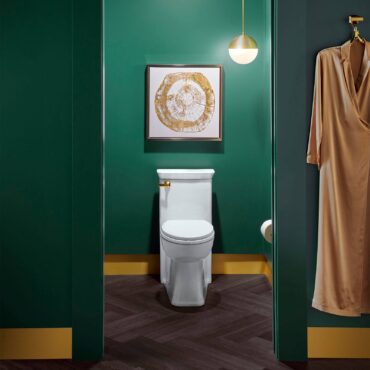
Toilets typically do not make for polite conversation. But when you think about how often people use a toilet and how many options you have when selecting the right one, maybe it’s high time to reconsider the perceptions of “toilet talk.”
Toilets come in two basic configurations: one-piece and two-piece. One-piece toilets are fabricated as one continuous piece of porcelain (or vitreous china), meaning that the toilet bowl and tank are fused. One-piece toilets can either be floor-mounted or wall-mounted (the tank is built into the wall and typically requires a 2-by-4-inch stud wall or a bump-out wall sized to the toilet).
Either type of installation makes cleaning the toilet a breeze. The added benefits of a wall-mounted toilet are:
- The toilet seat height can be set to the exact specifications of the user.
- It’s easy to clean under and around the toilet
- The toilet saves floor space in a small bathroom.
- It provides improved access for wheelchair users.
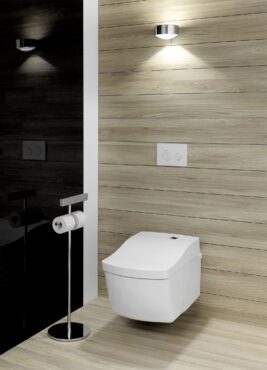
Two-piece toilets are just as they sound — they’re fabricated in two pieces, a bowl and a tank.
Before you get too far along in the toilet-selection process, it’s important to verify the “rough-in” dimension of any existing toilet flange. The rough-in dimension is the distance between the wall and the centerline of the toilet flange and is determined by the location of the mounting bolts on the toilet bowl base.
The most typical rough-in dimension is 12-inch, but 10-inch and 14-inch are also available. The rough-in dimension is often predicated on the location of the floor joist below the bathroom floor.
Both one- and two-piece toilets come in either a standard height, whereby the toilet bowl is approximately 14-15 inches above the floor; or comfort (“right”) height, with the seat approximately 16-19 inches above the floor.
Standard-height toilets have been an industry “standard” for many decades and are best suited to children and petite adults. This toilet height allows a person to use the commode while keeping feet on the floor (or on a small step stool), contributing to good gastro-intestinal health.
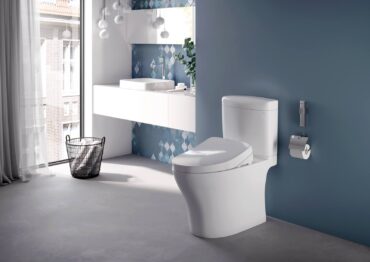
Comfort-height toilets are recommended for most adults. The extra height ensures ease of sitting down as well as ease of rising from the commode for the user.
Another characteristic common to both one- and two-piece toilets is the option for an exposed trap, whereby the shape of the internal trap is visible on the outside of the toilet; as well as a skirted-base toilet, which is fabricated as a solid piece of porcelain on the base (bowl). The benefit of the skirt is that there are fewer crevasses to clean than with an exposed-trap model. Most skirted toilets have a definite contemporary style; however, a few traditional styles are available.
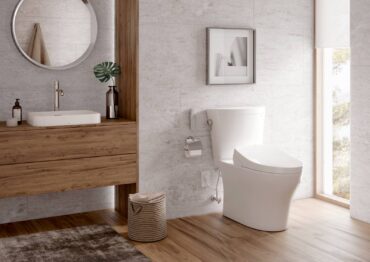
One characteristic typically not shared by the one- and two-piece toilets is the shape of the bowl. Toilet bowls are either round or elongated and one-piece toilets with round bowls are a rarity. Round bowls are shorter back to front and are best suited to small spaces, while elongated bowls can be up to 5 inches longer than a standard round bowl and are generally more comfortable for the users.
High-Efficiency Toilets
A federal mandate that went into effect in 1992 requires that toilets use no more than 1.6 gallons per flush. However, toilets now come in a variety of flush rates, ranging from 1.6 gallons down to 0.8 gallons.
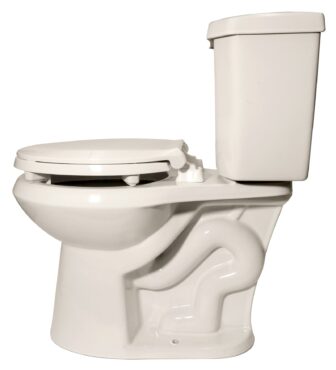
A toilet using 1.28 gallons or less per flush is considered HET (high- efficiency toilet). There are single-flush HETs and dual-flush HETs, whereby the user moves the actuator (flush handle located on the tank of the toilet) forward or back to minimize the water flow for liquid waste or maximize the water flow for solid waste.
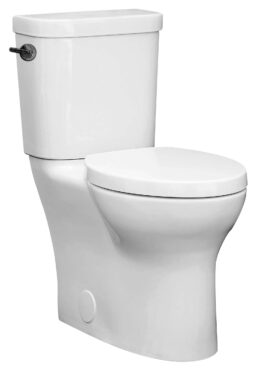
Conversely, dual buttons on the top of the toilet tank allow you to select the flow rate by the size of the button — small button for liquid waste and large buttons for solid waste. For wall-hung toilets, the dual-button actuator is installed on the wall to the side or behind the toilet.
You need to consider two things when you’re contemplating buying an HET toilet:
- The water level in the toilet bowl is higher with both a standard-flush and single-flush HET toilet than in a dual-flush HET toilet — the significance of this difference is that gravity has a way of demonstrating its power when eliminating solid waste, potentially leaving the user with a wet bottom.
- If your home is on septic rather than public sewer, the distance to the septic tank and the slope of the ground between the bathroom and the septic tank should be taken into consideration to avoid slow-moving black water and sewage, especially during warm weather months.
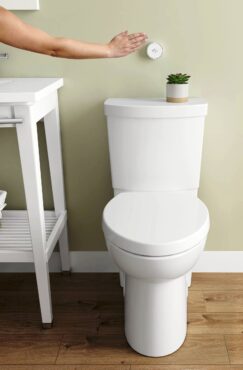
Flushing Options
There are a few different types of flushing options for both standard and HET toilets. They include:
- Gravity, whereby the introduction of water into the bowl uses the force of gravity to flush the toilet bowl clean of waste products. This style is typically very quiet.
- Pressure-assist, which utilizes compressed air, along with gravity, to remove waste from the toilet bowl. This style is good for households that tend to experience toilet clogs but you should know these toilets can be rather noisy, especially if activated in the dead of night.
- Double-cyclone, whereby water enters the bowl in two steady streams from near the top of the toilet bowl, flowing down in a swirling cyclone pattern to remove waste from the bowl. This style of flushing is relatively quiet.
Seat Choices
Most models of toilets don’t come with a toilet seat, which is sold separately. There are several types of toilet seats:
- Standard, usually plastic and plain vanilla in appearance; requires manual closing in order to be quiet.
- Soft-close, which can be either plain vanilla or styled and has a hinge that lowers the toilet seat quietly and efficiently without assistance (a good idea for couples with en-suite bathrooms).
- Elevated toilet seats, which effectively have spacers between the seat and the toilet bowl, making them higher than standard toilet seats and an optimal choice for people who use wheelchairs or have bad backs, hips or knees.
- Washlet or bidet seats (not to be confused with a floor-mounted bidet plumbing fixture). This type of toilet seat can be purchased as an accessory on the aftermarket or comes as an integral part of a toilet when fabricated.
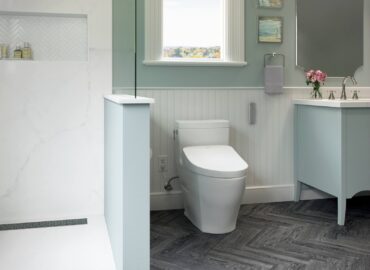
Bidet Seats
For the uninitiated, you may be wondering what exactly is a bidet seat. In a nutshell, a bidet seat is a heated toilet seat (good for relaxed toileting, especially for those individuals who may suffer from recurring constipation) that cleanses one’s posterior and anterior elimination points with heated water from a retractable wand (but not both areas at the same time) at the touch of a button. They also have warm air blowers to dry you. This eliminates the need for toilet paper (especially when people are hording TP) and provides people who have physical and visual limitations the ability to toilet themselves with comfort, independence and dignity.
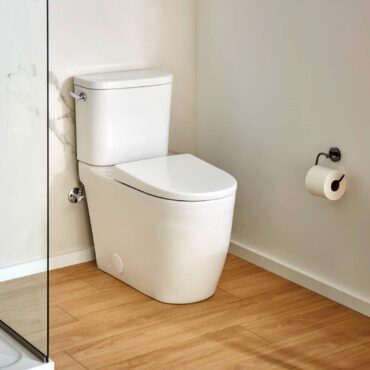
There are a variety of features to consider when purchasing a bidet seat. First would be: Do you have the requisite electrical outlet near the toilet to power the bidet seat? Second, do you want the bidet seat integrated into the toilet at the factory or as a standalone unit?
If you have an existing toilet that you like, then a standalone seat may be best and will be easier on the wallet. The drawback is that the water supply and power supply lines will be visible and therefore less aesthetic than the factory-integrated bidet seat.
Another key feature is whether the seat comes with a remote control or if the controls are mounted on the side of the toilet. Suffice it to say, when the controls are mounted on the side of the seat, the price tag will be palatable. But for many, seeing and actually using the seat’s various functions will be difficult unless they have excellent vision and sufficient upper torso flexibility.
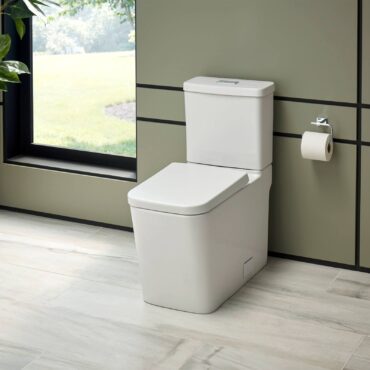
Additional features may include sensors that raise and lower the toilet seat, nightlights, automatic flushing and precleaning of the toilet bowl.
Often overlooked, composting toilets do not require water and effectively treat human waste by the biological process of composting. They are environmentally friendly and come in many portable models, allowing you to have a functioning toilet just about anywhere you are. Some nonportable models require electricity, and they’re not always “odor free.”
There are many options for consumers to consider when selecting a toilet. Avoid buyer’s remorse by visiting a plumbing showroom, where you are likely to find a variety of toilets on display, as well as models you can “test drive” in the showroom’s public restroom. Thomas Crapper, the English inventor of the toilet ballcock (tank-filling mechanism) in the later 19th century, would likely be pleased to know that not only is his invention still in use today but that the household toilet has become an object of interest and desire.




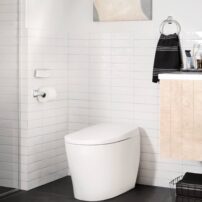
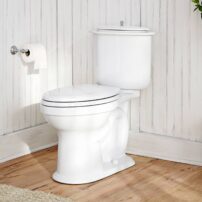
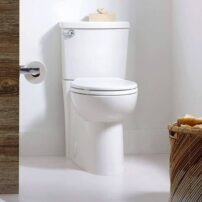
























Comments